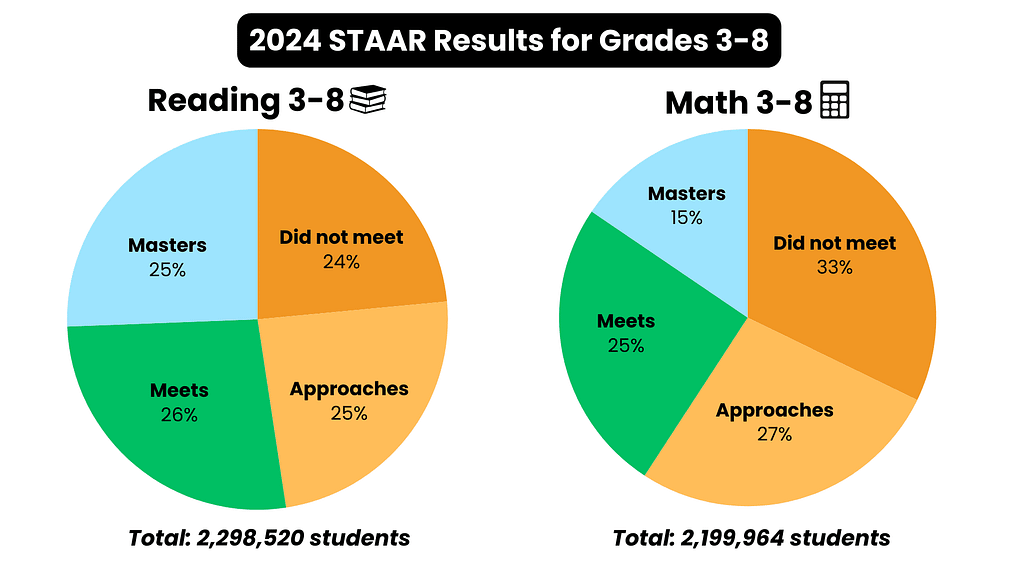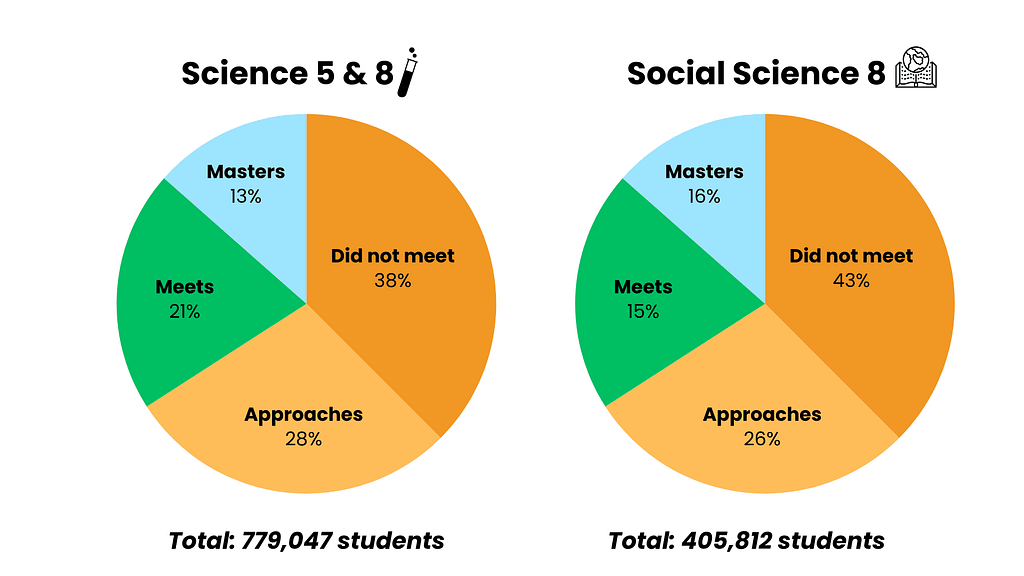STAAR results are in: Your questions answered
This is a preview of our Texas 2036 newsletter taking a deep dive into this year’s STAAR results and what they mean for the state. To receive this weekly look at our work, sign up here.
School’s Out and STAAR Results Are In.

Earlier this month, the Texas Education Agency (TEA) released the results from the State of Texas Assessments of Academic Readiness (STAAR) — the state’s only measure of how students are performing in reading, math and science.
Without STAAR, understanding how students are performing in each of the state’s 1,207 districts and public charter schools — which include nearly 9,000 campuses — wouldn’t be possible.
So, what do this year’s scores tell us?
The Big Picture: Challenges Loom for Texas’ Future

This year’s STAAR scores are mixed. While more students were reading at grade level than at any point in recorded Texas history, math performance in eighth grade has fallen substantially, with only 40 percent of students scoring at grade level or above.
The situation with fifth grade science students is even more dire. Only 26 percent are testing at grade level or above this year, reflecting a drop of 8 percentage points since last year and 21 percentage points since 2019.
What Do the STAAR Scores Mean for Students?

Student performance on STAAR is measured by four performance categories: Masters Grade Level, Meets Grade Level, Approaches Grade Level, and Did Not Meet Grade Level. Students scoring at “Approaches Grade Level” and “Did Not Meet Grade Level” are scoring below grade level expectations.
Texas law requires all students who do not achieve approaches or higher on STAAR grades 3–8 or on high school end of course assessments to be provided accelerated instruction.
All students can move on to the next grade: contrary to common belief, failing the STAAR exam in grades 3-8 does not require that a child be held back. Parents have the option of requesting that their child repeat a grade, but this is exceptionally rare. While 59 percent of math students are not at grade level, and 31 percent are at the lowest tier of “Did Not Meet Grade Level,” just 2.5 percent of students are held back annually.
To graduate, high school students must pass five end-of-course exams. Failing one or two requires them to seek review by the graduation committee. Failing more than two requires retesting.
By the Numbers: Texas’ Future in Context

Student scores in the “Approaches” category are considered passing but are not at grade level. Tutoring is required only for students in the “Did not meet” category.
Math: A total of 594,450 students across third through eighth grades are not performing at grade level but technically passed the STAAR.
Reading: Meanwhile, 554,506 students in third through eighth grade are not reading at grade level but technically passed the STAAR.
Science: And 221,294 students in fifth and eighth grade are not performing at grade level but technically passed the STAAR.
10 Fast Facts about STAAR

1.) The STAAR is administered each spring in grades 3-8, testing reading and math. Science is tested in fifth and eighth grades. Social studies is tested in eighth grade.
2.) High school students take a STAAR exam as an end-of-course assessment following Algebra I, English I, English II, Biology and U.S. History.
3.) Parents can directly access their children’s STAAR results at TexasAssessment.gov.
4.) The STAAR is designed to measure the extent to which students have learned the materials in the State Board of Education-mandated curriculum standards, known as the Texas Essential Knowledge and Skills (TEKS), for each grade level and subject.
5.) Every question on the STAAR test is reviewed and approved by a team of Texas teachers.

6.) Federal law requires that states administer periodic assessments on math, language arts and science. The other STAAR tests are required by state law.
7.) Following the passage of House Bill 4545 in 2021, students who perform at Did Not Meet Grade Level on the STAAR exam are entitled by law to free tutoring.
8.) The STAAR test has consistently been found by third-party entities to be a valid and reliable measure of student learning.
9.) The STAAR was first administered in the 2011-12 school year, then redesigned in 2023 to provide students with different ways to demonstrate their understanding of the curriculum and more closely mirror the classroom experience.
10.) The STAAR test is the first assessment in Texas’ history aligned with what students need to know to be academically successful after high school.
What Do the STAAR Scores Mean for Schools?

Texas provides annual academic accountability ratings to its public school districts, charters and schools. The A-F ratings are based on performance on state standardized tests; graduation rates; and college, career, and military readiness outcomes.
Districts with campuses receiving unacceptable performance ratings over a number of consecutive years are required to take a number of steps in order to turn around the campus and increase student achievement. After five years of consecutive failing ratings, one of the interventions can include a state takeover of the local school board.
TEA took over the Houston Independent School District last year, and STAAR scores have shown significant improvements in the first year of state involvement.
Texas’s A-F accountability system was paused by the courts last fall, leaving parents and local communities in the dark about school performance trends. Later this summer, we expect STAAR scores to be used in the updated A-F accountability system.
Why Do These Numbers Concern Us?

Economic Implications: Texas’ economic growth has relied on attracting educated workers from other states. As this trend slows, the state’s economy will depend on local talent. If students don’t acquire necessary skills such as reading and math, it could hamper Texas’ economic momentum and innovation capacity.
Workforce Readiness: Less than half of Texas students are performing at grade level in math and science. Only a quarter of fifth graders meet the science benchmark. These trends raise concerns for future STEM careers and skilled trades. How will these students fare in the job market when they graduate in 10 years and attempt to become plumbers, HVAC technicians, health care professionals, engineers, or work in the space sector?
Have you heard about the “Mississippi Miracle”?

Once the lowest-performing state in reading scores, Mississippi has seen remarkable improvements due to a robust early literacy program emphasizing phonics and reading comprehension. As a result, Mississippi has made significant gains in the National Assessment of Educational Progress (NAEP) reading scores, particularly in the fourth grade.
What Can Be Done in Texas?

Fortunately, there are proven methods that can help raise all skill levels.
Texas 2036 is focusing on building on measures passed by the Texas Legislature in recent years to require tutoring for students who fail and providing schools with high-quality instructional materials, by focusing on ways Texas can improve student math scores and college and career readiness.
What are your questions about STAAR that you’d like answered?


